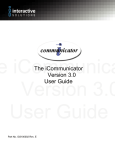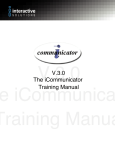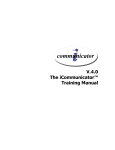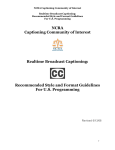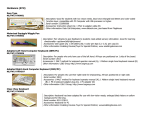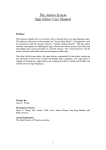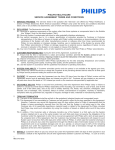Download User`s Guide - iCommunicator
Transcript
™ The iCommunicator Version 4.0 — User’s Guide Part No. IC6100047 Rev. A The iCommunicator User Guide This document is the copyright of PPR Direct,Inc. and is intended for exclusive use of PPR Direct customers. All rights are reserved. Information in this document is subject to change without notice. Companies, names, and data used in examples herein are fictitious unless otherwise noted. No part of this document may be reproduced or transmitted in any form or by any means, electronic or mechanical, for any purpose, without the express written permission of PPR Direct,Inc. © 2005 PPR Direct,Inc. All rights reserved The material in this document has been carefully reviewed; however, PPR Direct Inc. does not guarantee it to be free of all errors or omissions and reserves the right to make corrections, changes, updates, or revisions to the information contained herein. iCommunicator is a trademark of PPR Direct,Inc. Other than those held by PPR Direct,Inc., any other brand and product names referenced in this manual are trademarks of their respective holder and are used here for informational purposes only. PPR Direct,Inc. 74 20th St Brooklyn, NY 11232 The iCommunicator User Guide PPR Direct, Inc. SOFTWARE LICENSE AGREEMENT NOTICE TO LICENSEE: READ THE TERMS AND CONDITIONS OF THIS LICENSE AGREEMENT (“AGREEMENT”) CAREFULLY BEFORE OPENING THE PACKAGE CONTAINING THE PROGRAM DISKETTES, TAPE OR OTHER MEDIA, THE COMPUTER SOFTWARE THEREIN, AND THE ACCOMPANYING USER DOCUMENTATION (COLLECTIVELY THE “PROGRAM”), OR IF THE COMPUTER SOFTWARE IS PRE-INSTALLED, BEFORE USING THE PROGRAM. BY OPENING THE PACKAGE CONTAINING THE PROGRAM, OR OTHERWISE USING THE PROGRAM, IF THE COMPUTER SOFTWARE IS PRE-INSTALLED, YOU, AS THE LICENSEE (“LICENSEE”), ARE ACCEPTING AND AGREEING TO BECOME BOUND BY THE TERMS OF THIS LICENSE AGREEMENT. IF YOU ARE NOT WILLING TO BE BOUND BY THE TERMS OF THIS LICENSE AGREEMENT, PROMPTLY RETURN THE PACKAGE IN UNOPENED FORM WITHIN FIVE DAYS OF THE DATE OF PURCHASE TO RECEIVE A REFUND. THIS LICENSE AGREEMENT REPRESENTS THE ENTIRE AGREEMENT CONCERNING THE PROGRAM BETWEEN LICENSEE AND PPR Direct, Inc.(“LICENSOR”), AND IT SUPERSEDES ANY PRIOR PROPOSAL, REPRESENTATION, OR UNDERSTANDING BETWEEN THE PARTIES. THE PROGRAM IS NOT SOLD TO THE LICENSEE, BUT IS THE PROPERTY OF THE LICENSOR PROTECTED BY COPYRIGHT LAWS AND INTERNATIONAL TREATY. ANY USE OF THE PROGRAM IS GOVERNED BY THE TERMS OF THIS AGREEMENT. KEEP THIS AGREEMENT IN A SAFE PLACE, AS IT IS YOUR PROOF OF PURCHASE AND MAY BE REQUIRED FOR UPGRADE OR SUPPORT SERVICES. 1. License Grant. Licensor hereby grants to Licensee and Licensee accepts a non-exclusive license to use the Program Diskettes and the computer programs contained therein only in machine-readable, object code form (collectively the “Software”), and the accompanying User Documentation, only as authorized in this Agreement. The Program may be used only in a manner authorized by the manual, subject to the terms of this Agreement. If the product configuration for the Software that Licensee has licensed is designated as a “Single Machine License” on the Software packaging, the Software may be used only on a single computer owned, leased, or otherwise controlled by Licensee at a facility owned or leased by Licensee, or in the event of the inoperability of that computer, on a backup computer selected by Licensee. Neither concurrent use of the Software on two or more computers nor use in a system, multiple central processing units, emulations on a local area network or other network, or on a mainframe, micro or other central file or program server computer is permitted without separate authorization and the payment of additional license fees under a supplementary license. If the product configuration for the Software that Licensee has licensed is designated as a “Location License” on the Software packaging, the Software may be used only at one geographic location owned or leased by the Licensee on any number of computers owned, leased, or otherwise controlled by the Licensee, unless otherwise restricted to a specified number of computers by notice on the packaging. If the product configuration for the Software that Licensee has licensed is designated as a “Server License” on the Software packaging, the Software may be used only on a single server computer owned, leased or otherwise controlled by Licensee at a facility owned or leased by Licensee, and in connection therewith may be used in a related local area network or other intranet for any number of computers within the network, unless otherwise restricted to a specified number of computers, network users or clients by notice on the packaging. Certain additional or alternative restrictions may apply to the license of this Software. These restrictions, if any, are printed on the Software packaging, and when present, form part of this Agreement. Upon loading the Software into the computers specified by the terms of the product configuration identified on your Software packaging, Licensee may retain the Program Diskettes that Licensee has received for backup purposes. In addition, Licensee may make one copy of the Software on a second set of diskettes, CD-Rom disks or cassette tapes for the purpose of backup in the event the Program Diskettes are damaged or destroyed. Licensee may make one copy of the User’s Manual for backup purposes. Licensee shall reproduce and include the trade secret and copyright notices and any other proprietary legends that are on the original Program in all copies, in whole or in part, of the Program. Except as authorized under this paragraph, no copies of the Program or any portions thereof may be made by Licensee or any person under Licensee’s direction, authority or control. Licensee agrees to not assign, sublicense, transfer, pledge, lease, rent, sell, or share any rights granted under this Agreement, unless otherwise expressly authorized in writing by Licensor. Licensee will not disassemble, decompile, reverse engineer, copy, alter, or otherwise use the Software except as expressly authorized by this Agreement. 2. Restrictions. Licensee acknowledges and agrees that the Software and the User’s Manual, forms and other information supplied to Licensee by Licensor, and any copies thereof are proprietary products of Licensor protected under U.S. Copyright Law and International Treaty. Licensee further acknowledges and agrees that all right, title and interest in and to the Program, including associated intellectual property rights, are and shall remain with Licensor. Licensee agrees to take all reasonable steps necessary to protect the trade secrets and other property rights of Licensor. This Agreement does not convey to Licensee an interest in or to the Program, but only a limited right of use which is terminable in accordance with the terms of this Agreement. 3. License Fees. The license fees paid by Licensee are paid in consideration of the licenses granted under this Agreement. 4. Term. This Agreement is effective upon Licensee opening this package and shall continue until terminated. Licensee may terminate this Agreement at any time by returning the Program and all copies thereof and extracts therefrom to Licensor. Licensor may terminate this Agreement upon the breach by Licensee of any term hereof, and shall have the right to injunctive relief enjoining such acts or attempts constituting a breach (in addition to other legal remedies, all of which are non-exclusive). Upon such termination by Licensor, Licensee agrees to return to Licensor the Program and all copies and extracts thereof. 5. Limited Warranty. Licensor warrants solely to the original purchaser, for their benefit alone, that for a period of ninety (90) days from the date Licensee obtained the Program: (a) The Program components, including the Software and accompanying documentation, are free from defects in material or workmanship. (b) The Program is properly recorded upon the Program Diskettes, tape or other media. Additionally, Licensor warrants solely to the original purchaser, for their benefit alone, that for a period of ninety (90) days from the The iCommunicator User Guide date Licensee obtained the Program: (a) The documentation is substantially complete and contains all the information that Licensor deems necessary to use the Software. (b) The Program functions substantially as described in the documentation. The exclusive remedy for breach of this Limited Warranty is replacement of defective product. This Limited Warranty is extended only to the first purchaser of the Software. To replace a defective disk during the warranty term, send the defective disk and proof of purchase to: PPR Direct, Inc., 74 20th Street, Brooklyn, N.Y. 11232. DISCLAIMER OF WARRANTIES: THE WARRANTY STATED ABOVE IS THE ONLY WARRANTY APPLICABLE TO THIS PRODUCT. ALL OTHER WARRANTIES, EXPRESSED OR IMPLIED (INCLUDING, WITHOUT LIMITATION, ALL IMPLIED WARRANTIES OF MERCHANTABILITY OR FITNESS FOR A PARTICULAR PURPOSE), ARE HEREBY DISCLAIMED. NO ORAL OR WRITTEN INFORMATION OR ADVICE GIVEN BY PPR DIRECT, INC., ITS AGENTS OR EMPLOYEES SHALL CREATE A WARRANTY OR IN ANY WAY INCREASE THE SCOPE OF THIS WARRANTY OR THE OBLIGATION OF PPR DIRECT, INC. WITH RESPECT TO THE PROGRAM. THIS DISCLAIMER OF WARRANTIES AND LIMITED WARRANTY ARE GOVERNED BY THE LAWS OF THE STATE OF NEW YORK. 6. Limitation of Liability. Licensor’s cumulative liability to Licensee or any other party for any loss or damage resulting from any claims, demands or actions arising out of or relating to this Agreement, or in connection with the delivery, use or performance of the Program, shall not exceed the license fee paid to Licensor for the use of the Program. UNDER NO CIRCUMSTANCES SHALL LICENSOR BE LIABLE FOR ANY SPECIAL, EXEMPLARY, INCIDENTAL, OR CONSEQUENTIAL DAMAGES BASED UPON BREACH OR WARRANTY, BREACH OF CONTRACT, NEGLIGENCE, TORT, STRICT LIABILITY, OR ANY OTHER LEGAL THEORY, EVEN IF LICENSOR HAS BEEN ADVISED OF THE POSSIBILITY OF SUCH DAMAGES. SUCH DAMAGES INCLUDE, WITHOUT LIMITATION, LOSS OF PROFITS, LOSS OF REVENUE, LOSS OF USE OF HARDWARE OR ANY ASSOCIATED EQUIPMENT, COST OF CAPITAL, COST OF SUBSTITUTE OR REPLACEMENT EQUIPMENT, FACILITIES OR SERVICES, DOWN TIME, PURCHASER’S TIME, THE CLAIMS OF THIRD PARTIES, INCLUDING CUSTOMERS, AND INJURY TO PROPERTY. LICENSOR SPECIFICALLY DISCLAIMS ANY OBLIGATION TO INDEMNIFY LICENSEE FOR ANY ALLEGATIONS OR FINDINGS OF PATENT INFRINGEMENT BASED ON THE USE OR SALE OF THIS PROGRAM. 7. Trademark. PPR Direct, Inc. is a trademark of Licensor. No right, license, or interest to such trademark is granted hereunder, and Licensee agrees that no such right, license or interest shall be asserted by Licensee with respect to such trademark. 8. Governing Law. This Agreement shall be construed and governed in accordance with the laws of the State of New York. 9. Severability. Should any term of this Agreement be declared void or unenforceable by any court of competent jurisdiction, such declaration shall have no effect on the remaining terms hereof. 10. No Waiver. The failure of either party to enforce any rights granted hereunder or to take action against the other party in the event of any breach hereunder unless in writing, and in any event shall not be deemed a waiver by that party as to subsequent enforcement of rights or subsequent actions in the event of future breaches. 11. Export Controls. None of the Software or any underlying information or technology may be downloaded, used, or otherwise exported or re-exported except in compliance with all United States and other applicable laws and regulations. In particular, but without limitation, none of the Software or underlying information or technology may be downloaded, used or otherwise exported or re-exported (i) into (or to a national or resident of) Cuba, Haiti, Iraq, Libya, Yugoslavia, North Korea, Iran, Syria or any other country to which the U.S. has embargoed goods; or (ii) to anyone on the U.S. Treasury Department’s list of Specially Designated Nationals or the U.S. Commerce Department’s Table of Deny Orders. By downloading or using the Software, you are agreeing to the foregoing and you are representing and warranting that you are not located in, under the control of, or a national or resident of any such country or on any such list. 12. U.S. Government Restricted Rights. The Software and accompanying material are provided with RESTRICTED RIGHTS. Use, duplication, or disclosure by the Government is subject to subparagraphs (a) through (d) of the Commercial Computer Software - Restricted Rights clause at FAR 52.227-19 and its successors and counterparts, or in subparagraph (c) of the Rights in Technical Data and Computer Software clause at DFARS 252.227-7013 and its successors and counterparts, and to similar clauses in the NASA DFAR supplement or other revisions to the FAR sections, as applicable. Contractor/Manufacturer is PPR Direct, Inc. 74 20th St., Brooklyn, NY 11232. The iCommunicator User Guide Table of Contents PREFACE Customer Support Customer Service Defective or Damaged Products Notes II ii iii iv v CHAPTER 1: INTRODUCTION The iCommunicator Software Program Minimum Hardware Specifications 1-1 1-1 1-2 CHAPTER 2: GETTING STARTED 2-1 CHAPTER 3: USING YOUR ICOMMUNICATOR SOFTWARE PROGRAM Parts of the iCommunicator Program Main Screen Using the Menus The Control Window Quick Say Function Keys The Signing Window The Text Window Changing the Windows Theme Retrieving a Sign for a Word Using the Electronic Dictionary 3-1 3-1 3-3 3-8 3-12 3-17 3-19 3-19 3-21 3-22 CHAPTER 4: SPEECH RECOGNITION Creating and Managing Users Run General Training Again Correcting Speech Recognition Errors The Show Results Box Archiving and Restoring Speech/Voice Recognition Files 4-1 4-2 4-13 4-16 4-17 4-18 INDEX I-1 The iCommunicator User Guide i P Preface The iCommunicator software program provides the functions that lets you manage a full range of multimedia types, including full-motion video with CD-quality sound with a highend laptop or desktop personal computer. This guide gives you all the information you need to know—how to begin using the program, how to train your computer to recognize voice and speech patterns, and how to create and control text, sounds, and sign language videos. Customer Support Thank you for purchasing this product. PPR Direct is dedicated to ensuring that you gain the greatest possible value from our products. Please take a minute to learn about the support and services we offer. Note that the benefits and services offered by the manufacturer and its resellers are subject to change without notice. Training The iCommunicator Training Manual provides a systematic training process for end users, speakers, and implementation managers. Onsite training may be purchased through authorized iCommunicator resellers The iCommunicator User Guide ii Customer Service Customer Service is available to answer your questions about product availability, upgrades, features, customer registration, policies, procedures, and other non-technical topics. The following services are available to registered iCommunicator customers: Telephone Service You can call Customer Service from 8:00 AM to 5:00 PM, Monday through Friday (Eastern Time). The number is 718-965-8600. Registration Status Customer Service can answer questions about your registration status. Please have your product serial number ready when you call 718-965-8600. Change of Address Customer Service handles customer address changes. Send a letter that includes both your old and new address to: iCommunicator 74 20th Street Brooklyn, NY 11232 ATTN: CHANGE OF ADDRESS The iCommunicator User Guide iii Defective or Damaged Products Contact Customer Service if your product is damaged or defective. Be sure to have your product serial number ready when you call. Defective equipment will be warranted per the equipment manufacturer’s warranty statement. After the warranty period, one year from purchase, replacement parts are available to registered users at a nominal charge. Send the defective part, a brief explanation, and payment (if necessary) to: Customer Service iCommunicator 74 20th Street Brooklyn, NY 11232 Product Upgrades and Updates For warranty, upgrades, registration, change of address, and technical questions, call Customer Service at 718-965-8600. The iCommunicator User Guide iv Notes The iCommunicator User Guide v 1 Introduction Welcome to the iCommunicator, Version 4.0, software program. The iCommunicator program helps persons who are deaf, hard-of-hearing, or those with other communication challenges achieve two-way communication. It is an interactive solution to communication accessibility needs in educational, workplace, and public access venues. The iCommunicator is also a teaching tool that helps improve literacy skills. The iCommunicator software program converts speech into multiple streams of data for simultaneous presentation of text, video-sign language, and computer-generated speech. The iCommunicator software works with Dragon Naturally-Speaking speech recognition software allowing you to train your computer to recognize voice and speech patterns. The program stores these voice files for immediate access. The iCommunicator Software Program The iCommunicator software program converts human speech to digitally-imaged sign language, computer-generated speech, and text printed on the computer screen. Likewise, it lets you type words and phrases that the program converts to computer-generated speech and then relays to audio speakers or peripheral hearing devices. For persons with hearing loss, the iCommunicator program generates speech and sends it to cochlear implants, FM systems, and hearing aids. It provides a clear audio stream, devoid of extraneous background noises. The iCommunicator program lets you choose how you want to deliver your information. You can choose to activate sign language (with or without audio) and fingerspelling of words. It lets you control the speed of the information and the way the computer presents that information. You can also store up to 24 preprogrammed messages and deliver them simply by pressing assigned function keys. For more information on effective strategies for using the iCommunicator software program, consult the professional training manual. The iCommunicator User Guide 1–1 Minimum Hardware Specifications The iCommunicator software and peripheral kit includes: • iCommunicator Software Setup CD’s • Dragon NaturallySpeaking Setup CD’s • LightSPEED LES-360 FM System (or equivalent) o Wireless receiver o Wireless transmitter o Battery charger and cables o 2 NiMH rechargeable batteries o Noise canceling microphone o Microphone set-up guide • Visikey Wireless Keyboard • PS2 to USB adapter • iCommunicator Hardware Security Key • Audio Cables (2) • iCommunicator Installation Guide • iCommunicator Training Manual • iCommunicator User Guide • Registration Card The iCommunicator software application requires the following minimum laptop or desktop computer hardware and software: • • • • • • • • • Operating System: Processor: Memory: Hard Drive: USB or Parallel Port: Video: Display Resolution: Sound/Speakers: CD-ROM: Microsoft Windows XP or 2000 Pentium III, 800MHz 512 MB RAM (1GB recommended) 2GB available space on Drive C To attach hardware security key 8MB 800x600; high quality SoundBlaster Pro Compatible 24X (or DVD-ROM) The iCommunicator User Guide 1–2 Notes The iCommunicator User Guide 1–3 2 Getting Started Before you turn on your computer, connect all the hardware and verify that all the cables are properly secured. Refer to the iCommunicator Installation Guide included with your software and peripheral kit. • Connect the LightSPEED receiver (professional kit) or the direct-connect microphone (standard kit) to the microphone input jack on the PC. • Connect the audio Y-cable to the audio output jack (headphone) if the end-user will be using this feature. • Connect the AC power cord to your PC. • If your computer is a desktop PC, connect the keyboard, mouse, and monitor before you turn it on. • Power on the unit. • Verify that the batteries for the LightSPEED FM transmitter and receiver are fully charged. Fully charged batteries last for approximately five hours of normal use. We recommend that you change the transmitter batteries when the battery indicator light on the top of the unit shows a low (red LED) condition. • Install the software using the Installation Guide provided with your software kit. You will be performing either a new installation or an upgrade as described below. – New Installation. If you do not have a previous version installed on your computer, you will be completing a new installation. After installation, you will be directed to immediately Create a New User, that is, build a speech/voice recognition file. This is necessary so that you will be able to speak to your computer and have it recognize your speech and voice characteristics. Refer to Modules 3 and 4 in the Training Manual for directions. – Upgrade Installation. If you currently have the iCommunicator software V.3.X.0 installed, follow the iCommunicator V.4.0 Upgrade Procedure shipped with your software kit. The iCommunicator User Guide 2–1 3 Using Your iCommunicator Software Program Start the iCommunicator program from the Windows Start button, or double-click the icon on your desktop. The program is ready when the microphone is on. Note: We recommend that you close all other applications while using iCommunicator. Opening additional windows can slow your iCommunicator program. To begin using the iCommunicator program and peripheral kit after you properly install the software, you must first select the speech/voice recognition files you want to use. These are the files created in the New User Wizard. (Refer to Chapter 4, Voice Recognition). The speech/voice recognition files contain all the information that Dragon NaturallySpeaking gathers about the speaker. Parts of the iCommunicator Program Main Screen The following describes the elements of the iCommunicator window that are your tools for effective communication. You’ll learn more about how to use window elements throughout this manual. The following illustration shows the various elements of the iCommunicator screens and includes a brief explanation of each element. The iCommunicator User Guide 3–1 Signing Window: Speech and text are converted to sign language and fingerspelling in this window. You can change the speed of the signing. Control Window: Use the menu options to control the iCommunicator program. You can also send messages and note text from this window. Text Window: Text converted from speech appears in this window. Your iCommunicator program contains three windows joined together in one display. If you choose, you can separate the windows and control its size and display in the Custom Viewing mode. Your iCommunicator program remembers your window settings until you change them. The iCommunicator Windows • Control Window - This window controls the iCommunicator program’s speech recognition. You can change the speech recognition options, enter text for conversion to speech, enter text as a note, and manage your microphone. • Signing Window - This window displays sign language and fingerspelling videos. • Text Window - This window displays text converted from speech or text files. You can add your own notes to this window and save it in .RTF format. You can then later review the contents using iCommunicator, or edit the contents using a standard word processor. Text from email, web pages, or other application using this iText tool. The iCommunicator User Guide 3–2 Using the Menus The standard view iCommunicator screen has pull-down menus on its menu bar. Menus include: File, Views, Options, Actions, Signing Options, Font, and Help. To view the selections available in these menus, click the name of the menu you want to view. Move the mouse pointer down to highlight the item you want, and then click the left mouse button to select it. When you choose the custom mode, the menus function the same, but will appear on a different window. For example, the Signing Options menu appears on the Signing Window. File Menu Use To New Clear the text window and prepare a new file. When you select this option, the iCommunicator program removes the text from the window, but does not save it. If you want to save any text in this window, you must do so prior to selecting New. Open Open an existing text file. Save Save the changes to an existing file. Save As Name and save the text displayed in the Text window as a file. Exit Close the iCommunicator program and return to your desktop. You can also click on the X in the upper right corner of the Control window to exit the iCommunicator program. Views Menu Use To Themes Change the border display and color themes for the iCommunicator program windows. Standard Mode is selected Control the window display. A check mark indicates the iCommunicator is operating in the standard (three windows joined) mode. Deselect this menu option to separate and control the three windows independently. The iCommunicator User Guide 3–3 Options Menu Use To Microphone On Toggle microphone on or off. Autosave every (n) minutes Select automatic save options or restore the last auto save. The iCommunicator program saves the text window every 5 to 60 minutes. Speak Incoming Words Convert recognized words to audible, computer-generated speech and transmit it to the hearing assistive device. Set Talking Voice Change the tone, pitch and speed of the computer-generated voice. Choose between male or female voices. Edit Quick Say Keys Edit the Quick Say phrases assigned to function keys. The iCommunicator program stores up to twenty-four quick say messages. Clear Text Window when starting Display an empty text window each time you turn on the program. Start With Window When you select this option, the iCommunicator will open immediately when you start your computer. Speech Recognition Change the current speaker, add a new user, save speech files, run General Training for voice recognition, run Audio Wizard, delete a speaker, run Vocabulary Builder, or Show Results box. iText iText displays text from documents, email, web pages, and other applications in your computer’s iCommunicator text window, and then signs and/or speaks the text. The iCommunicator User Guide 3–4 Actions Menu Use To Reset Halt the computer-generated speech, turn off signing, and reset the microphone. Pause Temporarily halts the text window, signing, and computer-generated speech. Select Pause again to restart. Show Displays sign for a word selected with the cursor. Sign Text Window Sign the words in the text window without generating a voice. Speak Text Window Convert the words in the text window to audible computer-generated speech and send it to the hearing assistive device (without the Signing option). Sign and Speak Text Window Sign words in text window and generate audible computer-generated voice at the same time. You can choose where an action starts. Place your cursor in the text box and click where you want the action to begin before you select the Actions menu command. * Tip: The Action menu commands Reset and Pause also appear on the top border of the Text window. Simply click to use the Action command. When you click pause, the Text Window’s display changes to “Continue.” Click Continue to restart the action. The iCommunicator User Guide 3–5 Signing Options Menu Use To Word List Display a list of words in the signing video library. Choose a word from the drop-down list, and then click the check mark to view the associated signing video. Enable Signing Start or stop the signing videos. Fastest Set the signing speed at the fastest level. 7,6,5,4,3,2 Control the speed of signing. The higher the number you choose, the faster the signing. Slowest Set the signing speed at the slowest level. Font Menu The font menu lets you choose the font size for text in the text window. The default size id 16 points; however, you can choose from several options. Help Menu Use To Contents Display a list of help topics, view an index, or search the help system for a topic. Hot Keys Display a list of hot keys and their function. About Display license information about the iCommunicator program. The iCommunicator User Guide 3–6 Hot Keys and Shortcuts You can quickly execute iCommunicator menu commands using keyboard combinations. The key combination displays on the menu along with the command. To display a list of all hot keys, select Hot Keys from the Help menu. Hold the first key down (Ctrl or Alt), then touch the key shown with it to use the shortcut. Hot Key Combination Menu iCommunicator Menu Command Ctrl+A File Save As Ctrl+B Actions Sign and Speak Text Window Ctrl+D View Return to Defaults Ctrl+E View Enable Signing Window Ctrl+G Actions Sign Text Window Ctrl+H Help Displays list of Hot Keys Ctrl+I Options Speak Incoming Words Ctrl+K Actions Speak Text Window Ctrl+N File New Ctrl+O File Open Crtl+M Options Toggles microphone on/off Ctrl+P Actions Pause Ctrl+R Actions Reset Ctrl+S File Save Ctrl+W Signing Option Word List Ctrl+Enter N/A Notes Say This box The iCommunicator User Guide 3–7 The Control Window The Control window lets you manage speech options. Use the Control window to: • • • • change the speaker you want your computer to recognize manage the microphone enter text you want spoken add notes to the text window Menu Options: Select menu options to control iCommunicator. Current Speaker: Click here to select speech voice recognition files. Say This-Note This: Type your responses in this box. Click the down arrow to view previous messages. Microphone ON/OFF Button: Click here to turn microphone ON and OFF. The iCommunicator User Guide 3–8 Microphone Status Bar: Click here to toggle the microphone ON and OFF. Joining and Separating the Windows The iCommunicator contains three windows joined together. You can customize your program by turning off the standard mode. You can then control and move each of the three window elements independently. To separate and move a window: 1. From the Views menu, deselect Standard Mode is selected. The windows separate. 2. Click and hold down the left mouse button and drag the window to the desired location. 3. Release the mouse button. To move all windows at the same time: 1. Position your pointing device on a window border. 2. Hold down the right mouse button and drag to the desired location. To return to standard mode: • From the Control Window Views menu, select Change to Standard Mode. Minimizing and restoring the iCommunicator Windows The standard Microsoft Windows buttons located in the upper-right corner of the iCommunicator title bar provide a quick and easy way to minimize, maximize, restore, and exit the iCommunicator program. When you choose the custom (windows separate) mode, icons appear in the upper-right corner of each window. Use To Reduce (minimize) the iCommunicator program to a button on the task bar. Click the taskbar button to open iCommunicator again Decrease the Control Window Size. Increase the Control Window Size. Exit the iCommunicator program and return to your desktop. The iCommunicator User Guide 3–9 The Microphone Status Bar The microphone status bar show how your microphone is working. Color appears over the background to indicate the current status. Color Status yellow on and ready to receive speech green in use and receiving red audio level too high black microphone off * Note: Run the Audio Wizard option if you see red on the microphone status bar. (Refer to Chapter 4, Audio Wizard) Use the microphone status bar to turn the microphone off and on. Move the mouse pointer directly over the microphone status bar and click it once to turn the microphone OFF. Click again to turn ON. The default is ON. Microphone ON/OFF Button Click the ON/OFF buttons to manage the microphone. The iCommunicator User Guide 3 – 10 The Say This/Note This Text Box The iCommunicator program enables the computer to speak for you. Type what you want to say and press Enter. The iCommunicator program converts the text to computer-generated speech and sends it to speakers and to hearing assistive devices. You can also use the Say This/Note This text box to add your own notes to the text window. Press the Control/Enter to include your note. Notice that iCommunicator encloses your notes with arrows. The Note This function does not generate voice. The Speaking Status Bar The speaking status bar shows your program is processing the words you type in the Say This/Note This text box. Color flashes over the background to indicate computer-generated voice is transmitting. When transmission is complete, the speaking status bar disappears. Speaking Status Bar: Appears when processing Say This/Note This text box. The iCommunicator User Guide 3 – 11 Quick Say Function Keys You can preprogram up to twenty-four Quick Say messages and initiate audible, computer-generated speech by pressing the function key assigned to your message. The iCommunicator program converts the text to a computer-generated voice and relays it to speakers and hearing assistive devices. Click in the check box to view the second set of Quick Say buttons. Press Shift and the function key to speak the additional messages. You can enter twelve Quick Say messages in this screen. Press a function key to tell iCommunicator to say that message. Note: When you press a function key, iCommunicator first displays the message in the Say This, Note This text box. You can add more text, if you choose. Press Enter to say the message. To Create a quick message: 1. From the Options menu, select Edit Quick Says Key. The Edit Quick Say Keys box appears, listing function keys F1 through F12 along with an associated text box. 2. Choose a function key and type your message in the text box beside it. The text line is not limited to the line size or window area, so you can continue typing up to 256 characters. Repeat step 2 for each function key you use. 3. Click Save to store your Quick Say messages. 4. Choose Exit to return to your iCommunicator window. * Tip: If you want to assign twelve more messages, check the “Show Shift” box and continue entering messages. The iCommunicator User Guide 3 – 12 Delivering Quick Say Messages To deliver a quick say message: 1. Press the function key you assigned for the message. Your preprogrammed message appears in the Say This /Note This text box. 2. Press Enter. The iCommunicator program sends the message to the speakers and hearing assistive device. * Tip: Deliver the first twelve Quick Say messages by pressing the appropriate function key assigned to your message. Deliver the second twelve Quick Say messages by pressing the shift key and the appropriate Reviewing Quick Say Messages You can review your last ten Quick Say messages. Click the list button in the Say This/Note This box to view your messages. The iCommunicator User Guide 3 – 13 Set the Talking Voice You can select the voice, pitch and speed for iCommunicator’s voice. To set iCommunicator’s talking voice. 1. Select Set Talking Voice from the Options menu Click on the down arrow to see a list of talking voice options. Click and highlight the one you desire. Click and drag the sliders to set the desired pitch and speed of the talking voice. Press the Test button to listen to the selected voice. When you’ve finished setting the talking voice to levels that suit you, click the Accept Changes button to save your settings; otherwise, click the Discard Changes button and begin again. 2. Click the Talking Voice list button and select a voice. 3. Press the Test button to test the voice. 4. Move the sliders to set the pitch and speed. 5. Choose Accept Changes to save your selection, or choose Discard Changes to begin again. The iCommunicator User Guide 3 – 14 iText Tool Use the iText tool to have documents, email and web pages signed and/or spoken through the iCommunicator program. iText captures text from web pages, emails, word processing documents, and other software applications and immediately displays it in the iCommunicator Text window in the Standard viewing mode. Follow these directions to use iText. 1. Open the iCommunicator program. a. The iText button will display in your computer’s Systray. b. From the Options menu, selected iText_Default Left Click Action. Click on the desired action. c. From the Options menu, select iText_Pause Before Action. Select the delay time before the action starts in the Text window. The iCommunicator User Guide 3 – 15 2. Select and open a document in another application, such as Word, Excel, PowerPoint, an email message, or a web page. Place the cursor in that text. 3. To capture all of the text in the document: a. Click on the iText button in the Systray. b. Text will display in the iCommunicator Text window and the chosen action will begin. 4. To capture selected text in the document: a. Highlight the text you wish to have signed and/or spoken. b. Right click on the iText button in the Systray. A pop up menu displays c. Left click on the desired action for the selected text (i.e., sign, speak, sign and speak). d. Selected text will appear in the iCommunicator Text window. Text will be signed and/or spoken according to the action from the pop-up menu. Loading a Speaker’s Speech Files To recognize incoming speech, you must tell the iCommunicator program which speech files to use. Refer to Chapter 4 for more information about speech files. To load speech files: 1. Click the current speaker’s name at the bottom of the Control Window to display a list of speakers. or From the Options menu, select Speech Recognition Change Current Speaker. 2. Select a speaker name from that list. You will see the message, “Change active speech files. Please wait.” When the iCommunicator program is ready to receive, the new speaker’s name appears at the bottom of the Control Window. The iCommunicator User Guide 3 – 16 The Signing Window The signing window displays sign language and fingerspelling videos. To turn on the signing options: • From the Options menu, choose Enable Signing. A check mark appears on the menu. To turn signing off: • Click Enable Signing again. The check mark disappears; indicating the signing option is disabled. To control the speed of signing • Select Options and choose a signing speed. The higher the number you choose, the faster the signing. The iCommunicator User Guide 3 – 17 Locking and Unlocking the Signing Window You can choose to turn off and lock the signing feature. When you choose the Signing Locked option, all commands for the signing option disappear from the iCommunicator menus. A check mark appears on the Options menu to indicate signing is locked. A user cannot unlock and use the signing feature unless they enter the correct password. To lock or unlock the signing window. 1. From the Control Window Options menu, choose Signing Locked. The password window appears. 2. Enter a password in the Password window text box. * Note : defaultpassword is the password when the iCommunicator program ships from the factory. You must type defaultpassword in the text box before attempting to lock signing or change the password. 3. Choose the Enter button to enter a password, the Change button to change your password, or the cancel button to close the password window without changes. Follow the instructions on your screen. * Important: Remember the password you enter. You will need it to unlock the signing feature. The iCommunicator User Guide 3 – 18 The Text Window As iCommunicator recognizes speech, it converts it to text and displays it in the Text window. You can also enter text from the keyboard. For example, you may want to insert notes during a classroom lecture, or simply display your two-way conversations. Use the Font menu to change font size. To add your own notes to the text window. 1. Click in the Say This/Note This text box. 2. Type your text. 3. Press the Control and Enter key. Your notes appear in the text window enclosed by arrows. Changing the Text Window Font Size You can change the look of the text by changing the font size. To change the font size in the Text Window. 1. From the Font menu, select the size you want, and then click OK. The iCommunicator User Guide 3 – 19 Saving the Contents of the Text Window The iCommunicator program lets you save the information it displays in the text window. Once saved, you can edit it using a word processor, such as a Notepad or Microsoft Word. To save the contents of the text window. 1. From the File menu, select Save As. The Save As dialog box appears. Select Directories and drives from the Directories list, if you want to save a copy in a different directory or drive. 2. In the File name text box, enter the name of the file. 3. Choose Save. The iCommunicator User Guide 3 – 20 Clearing the Text Window You can clear the contents of the Text window. To clear the text window. 1. Select New from the File menu. The program will prompt you to confirm your action. 2. If you are sure you want to clear the text window, choose Yes. To clear the contents of the text window each time you turn the program on. • Select Clear Text Window when starting from the Options menu. Changing the Windows Theme You can choose from several preprogrammed themes to change the look and color of the iCommunicator windows. To Change your window theme: 1. From the Views menu, select Themes. 2. Choose a theme name. Retrieving a Sign for a Word There are two ways to retrieve a sign for a word displayed in the text window. Place the cursor on a word, such as numerous. If the sign is not in the video sign language dictionary, the program fingerspells the word. Do one of the following: • Double click on the word with the left mouse. • Click the Show button on the Text window border. The sign for the word displays in the Signing window. Another option for displaying the sign for a word is to select Word List from the Signing Options Menu. An alphabetical list of words in the signing video library appears in the dropdown list. Choose a word and then click the check marks to view the accompanying signing video. The iCommunicator User Guide 3 – 21 Using the Electronic Dictionary You can obtain the definition for a word displayed in the text window by placing the cursor on the word. Then press Shift + Right click to reveal the definition. The electronic dictionary will also pronounce the word when you click on the “Say” icon. The iCommunicator User Guide 3 – 22 Notes The iCommunicator User Guide 3 – 23 4 Speech Recognition Before the iCommunicator program can have two-way communication, each speaker must train the program to recognize his or her voice and speech patterns, Once trained, the iCommunicator program can then match the speaker’s specific sound patterns to words. The following lists important tips for successful speech and voice recognition training. • Consistent microphone positioning is important to maintain a high level of translation accuracy. Squeeze the foam widescreen over the microphone to help identify the surface of the microphone. ° The LightSPEED boom microphone should be positioned along the left jaw line, about an inch from the left corner of the mouth. For maximum performance, the rounded portion of the LightSPEED microphone element should be positioned in front of the chin and not directly in front of the mouth. The flat side of the microphone is then directed away from the face. ° The Parrott Bermuda microphone should be positioned along the jaw line. The flat part of the Parrott microphone should be worn so it is located one finger-width from the corner of the mouth. • Check the LightSPEED battery indicator light on both the receiver and transmitter frequently. Red indicates the unit is on and has battery power. The LED does not illuminate when the battery power is exhausted. • Speak clearly and continuously. Maintain your normal vocal effort and volume, and speak all words completely. • Correct recognition mistakes and add words to the vocabulary. • Speak to your computer to increase recognition accuracy. The iCommunicator User Guide 4–1 Creating and Managing Users To train the iCommunicator program, begin by using the New User Wizard. After the software has been installed, it is necessary to Create a New Speaker in order to use the software program. The New User Wizard prompts you to create new user voice files. It usually takes about ten to fifteen minutes to complete the New User Wizard. Begin reading aloud while Dragon NaturallySpeaking tests your voice for pronunciation, volume, and speed. The New User Wizard window has elements that work the same as the elements in other Windows applications. If you are not familiar with basic Windows elements, we suggest you refer to your Windows User Guides for a complete explanation of Windows elements To create a new user: 1. From the Control window Options menu, choose Speech Recognition and Create New Speaker. The iCommunicator User Guide 4–2 The New User Wizard window appears. Type the desired name in the Your name field, and then click the Advanced button. 2. Read the screen information, and then click OK. In the Advanced window, ensure that the Speech Model is BestMatch III. If not click the dropdown menu and select it. Verify that the Vocabulary Size option is set to Large. If not, select it from the dropdown menu, and then click OK. The iCommunicator User Guide 4–3 The New User Wizard’s Create User window reappears. 3. On the Create User window, enter a unique name for the user. 4. Choose a Language type (US English most common) and Dictation source (Microphone plugged into Mic-in Jack most common). 5. Select the Advanced button to choose a speech model and vocabulary size. You must select the BestMach III Model as the speech model, and Large as the Vocabulary size. 6. Choose OK to accept your changes. 7. Click Next. Read and follow the instructions for connecting your microphone, choosing your input device, and positioning your microphone. Continue to Calibrate your microphone’s volume. The iCommunicator User Guide 4–4 Calibrating your Microphone’s Volume Calibrating your microphone’s volume is important to achieve successful voice recognition. To adjust the microphone volume. 1. Click the Start Volume Check button. Click the Start Volume Check button and follow the instructions as they appear in your window. Your computer will adjust the volume setting for your voice. Be sure to speak clearly and in your normal voice. When the computer beeps, the process is done. 2. Begin reading aloud. 3. When the volume level is set, click Next to continue. When the volume adjusts successfully, the message “Finished” appears in the Volume status area of the adjustment screen. The iCommunicator User Guide 4–5 Checking Audio Quality To check your audio quality: 1. Click the Start Quality Check button. Click the Start Quality Check button and follow the instruction in your window. Your computer will check the audio quality of your microphone. Be sure to speak clearly and in a normal voice. When the computer beeps, the process is done. 2. Read the paragraph in the middle of the screen. When the quality check completes, a message displays along with the signal-to-noise ratio value. A minimum value of 22 is required. A value in the mid twenties to low thirties range is common. A lower value will degrade speech recognition performance. 3. Click The Next button. Continue with general voice training. * Note: You must complete the General Training to create a new speaker. The iCommunicator User Guide 4–6 General Voice Training To begin general voice training: 1. Click the Go button at the bottom of the New User Wizard Train Dragon NaturallySpeaking screen. 2. Read the text aloud as it appears in the window. When you complete the required reading, the Select Text screen appears. 3. Select a story from the list box, and click OK. Each Story takes approximately ten minutes to read. As Dragon validates your reading, a yellow arrow progresses. 4. Click the Go button and begin reading aloud. After completing the General Training portion, the program should know your voice well enough to accurately recognize what you say. However, reading additional stories may increase accuracy. We also recommend that you run Vocabulary Builder to increase recognition accuracy. The iCommunicator User Guide 4–7 Vocabulary Builder Vocabulary Builder analyzes documents that already exist on your computer, such as textbook glossaries and chapter summaries, technical documents, manuscripts, class rosters, and vocabulary lists. It gathers information about your specific writing style and identifies any new words so you can add them to the vocabulary. To start Vocabulary Builder: 1. From the Options menu, select Speech Recognition, Vocabulary Builder, Vocabulary Builder. A warning screen appears. 2. Choose Yes to continue to Vocabulary Builder, or No to cancel the procedure. The Vocabulary Builder Welcome screen appears. 3. Read the information screen and click Next. 4. (Optional) type the file path to the file containing a list of words you want. The iCommunicator User Guide 4–8 to add, or click Browse to find the file. * Note: When you add words this way, you will not have the opportunity to automatically train unfamiliar words. Use Analyze documents to both add words and train. (See next step). * Note: The word list must be in .TXT format. 5. If you specify a file, click Add Words from List and click Next. To skip this step, click Next. To analyze documents: 1. Click Add to select a document to analyze, and click Open. You can select multiple documents by holding down the Control key while you select. Your selections are added to the document list. The iCommunicator User Guide 4–9 2. To begin analyzing your documents, click Analyze Documents. As document analysis completes, the Analyzed column displays the word “Yes”. 3. When the program is finished processing all your documents, click Next. Vocabulary Builder displays a list of new words found on the Add New Words dialog box. You can add these words to the vocabulary to improve accuracy. The iCommunicator User Guide 4 – 10 To add new words: 1. Click the words you want to add to the vocabulary, then choose Add Checked Words to Vocabulary. The message “Do you want to train the newly added words now?” appears. 2. Choose Yes, then click record to voice train the new words. 3. Click Done, when you complete the new word training. 4. Click Next to continue. The Adapt to Document Style screen opens. 5. Select Yes to both options on the Document Style screen and click Next. 6. Review the summary information and click Finish to save your changes. The iCommunicator User Guide 4 – 11 Adding Additional Users When a new speaker wants to use the iCommunicator program, that person needs to create his or her own speaker files. Always remember to switch to the appropriate speaker before using the iCommunicator program; otherwise, the program may fail to interpret voice accurately. To add new users, follow the steps described earlier for the New User Wizard. Opening Speech Files When a new speaker begins talking, you must open that speaker’s voice file. To open a speech file: 1. Click the current speaker name at the bottom of the Control window. A list appears showing the names of all users. 2. Select a user name, or from the Options Menu select Speech Recognition, Change Current Speaker, Speaker’s speech/voice file name. You see the message, “Changing active speech files, please wait.” When the program is ready to receive the new voice, the speaker’s name appears at the bottom of the Control window. Deleting a Speaker If you are certain that you no longer need a speaker file, you can delete it. Once you delete a speaker file, it is gone forever. Make sure you don’t need it before you remove it. Always use the Delete Speaker menu selection to delete speaker files. Delete Speaker is the only way to properly remove all information about a user. To delete a user 1. At the Control window Options menu, select Recondition and Delete Speaker. 2. From Speaker list box, select the name you want to remove, then click Delete and answer yes to the prompt. 3. The Done window appears. Click OK. * Tip: If you want to delete the open user, you must close it first by selecting and opening a different user. The iCommunicator User Guide 4 – 12 Run General Training Again If you follow the instructions in this chapter and still have some speech and voice recognition errors, the iCommunicator software program may need additional training. Spend additional time training the program, and you will see an improvement in its translation accuracy. Complete an accuracy check found in the Training Manual. You may run General Training again and engage in more vocabulary building. To run General Training again: 1. From the Control window Options Menu, select Speech Recognition and Run General Training. A warning screen appears. 2. Choose Yes to continue with General Training, or No to cancel the procedure. 3. Select a story. 4. Click the Train Now button to continue. 5. Click the Go button when you are ready to begin training. 6. Follow the screen instruction. The more you read, the more the speech recognition software learns about your sound patterns. The General Training session typically takes approximately thirty minutes. 7. When you are finished reading, click Finish. For more detailed instructions, refer to General Voice Training described earlier in this chapter. The iCommunicator User Guide 4 – 13 Run Audio Wizard The Audio Wizard sets your microphone and sound system for optional speech recognition. If your microphone status bar continually shows red, you may have an audio problem. Run Audio Wizard to readjust your audio levels. You should rerun Audio Wizard any time there is a change in your voice or the acoustical environment, and when you change microphones. If you voice train in a different environment from where the iCommunicator is routinely used, rerun the Audio Wizard in the new environment. To run Audio Wizard: 1. From the Control window Options menu, choose Speech Recognition, Run Audio Wizard. A warning screen appears. 2. Choose Yes to continue to Audio Wizard, or No to cancel the procedure. When you choose yes, the Audio Wizard Welcome screen appears. 3. Follow the instructions on the screen. Refer to Calibrating your microphone and Checking Audio Quality for more detailed instructions. The iCommunicator User Guide 4 – 14 Using Vocabulary Editor If the program does not recognize a word or a phrase correctly, use Vocabulary Editor to train the program. Vocabulary Editor lists all words in your active vocabulary and lets you add, delete, and train the program to understand you pronunciation. To run Vocabulary Editor: 1. From the Control window Options menu, choose Speech Recognition, Vocabulary Builder, and Vocabulary Editor. A warning screen appears. 2. Choose Yes to continue with Vocabulary Editor or No to cancel the procedure. 3. Type or locate the word you want to train in the written form word list. If the word does not appear, add it to the active vocabulary before you train it. The iCommunicator User Guide 4 – 15 4. Select the word. * Note: To select more than one word, hold down the Ctrl key while you select. 5. Click the Train button. 6. Choose Record. The word or phrase appears in the written form column of the Train Words box. 7. Speak the word or phrase clearly. 8. Click Done. Correcting Speech Recognition Errors When iCommunicator translates a word or phrase incorrectly, it is important that you correct its recognition mistake. Correcting mistakes teaches the program not to make the same mistakes again and makes iCommunicator more accurate. You can correct mistakes as soon as they happen or go back and correct them later. When you see a mistake in your last word or phrase, you can stop and correct it by saying, “correct that.” To correct your last word or phrase. 1. Repeat the word or phrase once so that it appears (incorrectly translated) on a line by itself. 2. Say “Correct That”, and then wait until the Correction window appears. 3. If the correct word or phrase appears on the Correction window’s choices, select it. OR Click on “Spell That.” If the correct word or phrase appears as a choice, select it. If the correct word or phrase does not appear, type it into the text box. The iCommunicator User Guide 4 – 16 4. Place a check in the “Train how to pronounce this” box. Then click OK. The Train Words window appears with both the correct and incorrect word. Teach the program how each word sounds as you record them. 5. Choose “Go,” speak the first word in the text box, and then speak second word. 6. Click Done. 7. Save your speech files (Options Speech Files). Speech Recognition Save To go back to correct a word or phrase: 8. Say “Correct (x)”, where (x) is the word or phrase you wish to correct. 9. Follow the steps above. * Tip: After you correct a word or phrase, use it in a sentence so the program recognizes it in context. Refer to your Dragon NaturallySpeaking User’s Guide or Help Menu for more information. The Show Results Box You can choose to turn on a small window that displays the result of the voice analysis as it occurs. This feature will help you analyze recognition problems. To turn on the Show Results box: • From the control window Options menu, select Voice Recognition, Show Results Box. A small window appears in the upper left corner of your desktop. A check mark appears on the menu option. To turn off Show Results: • Select Show Results Box again. The check mark disappears. The option is disabled. The iCommunicator User Guide 4 – 17 Archiving and Restoring Speech/Voice Recognition Files There may be times when it is necessary to backup a speaker’s speech/voice (S/V) file: • a speaker completes S/V recognition training on one computer and needs to transfer the S/V file to another computer. • to remove a speaker’s S/V file from a computer and save it for future use. This file size limits storage to Zip Drives, Local Area Network (LAN), LS-120 SuperDisk Drives, or CD-R (W) Drives. Follow the procedures below to archive and restore a speaker’s S/V recognition file. Review each procedure before initiating the process. Location Each speaker who establishes a S/V file in the program has his or her own named folder inside the Users folder. S/V files for iCommunicator V. 3.1 are located in C:\Program Files\Dragon\NaturalSpeaking\User\Speaker S/V file name. Archive Procedure Use Windows Explorer to copy S/V files to the appropriate external device destination, such as a Zip Drive, LAN, Superdisk Drive, or CD-R/W. 1. From the Windows Start button, select Programs } Accessories } Windows Explorer. 2. To back up all S/V files on the program, navigate to the User folder (My Computer, C: Drive, Program Files, Dragon, NaturallySpeaking, Users, Speaker S/V files names). Select the User folder, and then copy it to the appropriate destination. 3. To backup a specific S/V file, navigate down one level and then select speaker’s S/V folder you wish to backup. (From the left panel select My Computer. Then select the following path: C:\ProgramFiles\Dragon\NaturallySpeaking\Users\ Speaker S/V file name). 4. Copy the speaker’s S/V folder to the appropriate destination. The iCommunicator User Guide 4 – 18 Restoring Speaker S/V Files 1. To restore all speakers, copy the previously backed-up User folder to drive C:\Program Files\Dragon\NaturallySpeaking. * Tip: This process replaces all speaker files currently on the iCommunicator program. If S/V files on the program are valid, use the backup procedure described above before initiating the restore process. 2. To restore a specific S/V file, copy the speaker’s S/V backup file to drive C:\Program Files\Dragon\NaturallySpeaking\User\Speaker S/V file name. 3. Start iCommunicator. 4. From the Options menu, select Speech recognition } Create New Speaker. 5. Enter the correct voice file name in the Your Name field, and then continue until the Audio Wizard Setup is complete. 6. Select Cancel and close the iCommunicator program. 7. You must run Audio Setup the first time you use the restored S/V files. The iCommunicator User Guide 4 – 19 Notes The iCommunicator User Guide 4 – 20 Index A E Actions menu, 3-5 Actions Menu pause, 3-5 reset, 3-5 sign text window, 3-5 speak and sign text window, 3-5 speak text window, 3-5 Adding users, 4-12 Audio Quality checking, 4-6 Audio Wizard run, 4-14 Elements iCommunicator program, 3-1 Exit iCommunicator program, 3-9 F File menu, 3-3 Function Keys quick say messages, 3-12 G General Voice Training, 4-7 Getting Started, 2-1 H C Calibrating your Microphone’s Volume, 4-5 Changing the windows theme, 3-21 Changing the Font Size text window, 3-19 Clearing text window, 3-21 Color Overlays microphone satus bar, 3-10 Computer-generated Speech set the talking voice, 3-14 Connecting hardware, 2-1 Control window, 3-8 Control Window resizing, 3-9 Correct That Speech recognition errors, 4-16 Correcting speech recognition errors, 4-16, 4-17 Create New User/New Speaker 4-2, 4-3, 4-4 Hardware, 1-2 connecting, 1-2 introduction, 1-1 Hot Keys, 3-7 I iCommunicator program exit, 3-9 windows, 3-2 iCommunicator System starting, 3-1 iCommunicator Windows control window, 3-2 elements, 3-2 minimizing and restoring, 3-9 signing window, 3-2 Important Tips speech recognition, 4-1 Introduction Hardware, 1-2 iText Tool, 3-15, 3-16 D L Deleting a Speaker, 4-12 Delivering quick say messages, 3-13 Loading a Speaker’s Speech Recognition Files, 3-16 Locking signing window, 3-18 The iCommunicator User Guide I–1 M Menu actions, 3-5 file, 3-3 options, 3-4 views, 3-3 Menu Commands hot keys, 3-7 shortcuts, 3-7 Menus using, 3-3 Microphone status, 3-10 Microphone Status Bar color overlays, 3-10 turning microphone off, 3-10 turning microphone on, 3-10 Microphone Volume adjust, 4-5 Minimizing and Restoring the iCommunicator windows, 3-9 Pause computer generated speech, 3-5 signing, 3-5 text window, 3-5 Q Quick Say Function function keys, 3-12 delivering, 3-13 reviewing, 3-13 R New User Wizard create a new user, 4-2, 4-3, 4-4 Reset computer-generated speech, 3-5 microphone, 3-5 signing, 3-5 Resizing control window, 3-9 Results Box show, 4-17 Reviewing quick say messages, 3-13 Run audio wizard, 4-14 general training again, 4-13 O S Opening speech files, 4-12 Option Menu clear text window when starting, 3-4 edit quick say keys, 3-4 set talking voice, 3-4 signing locked, 3-4 speak incoming words, 3-4 speech recognition, 3-4 Saving contents of the text window, 3-20 Say This/Note This Text Box, 3-11 Selecting a Speaker loading speech recognition files, 3-16 Set the Talking Voice computer-generated speech, 3-14 Shortcuts hot keys, 3-7 Show results box, 4-17 Sign text window, 3-5 Signing Window, 3-17 locking, 3-18 password protect, 3-18 Speaker deleting, 4-12 N P Parts of the iCommunicator Screen control window, 3-8 the say this/note this text box, 3-11 windows, 3-2 Password Project signing window, 3-18 The iCommunicator User Guide I–2 Speakers adding, 4-12 Speech Files opening, 4-12 Speech Recognition create new speaker, 4-2 important tips, 4-1 Speech Recognition Errors correct that function, 4-16, 4-17 Speech Recognition Files loading, 3-16 Start vocabulary builder, 4-8 Starting iCommunicator program, 3-1 Status microphone, 3-10 Vocabulary Editor using, 4-15 Voice Recognition general training, 4-7 W Window control, 3-2 signing, 3-2, 3-17 text, 3-2 Window Elements iCommunicator program, 3-1 Windows moving and resizing, 3-9 Window Theme changing, 3-21 T Talking computer-generated speech, 3-14 setting the voice, 3-14 Talking Voice setting, 3-14 Text Window, 3-19 changing font size, 3-19 clearing, 3-21 saving the contents, 3-20 sign, 3-6 speak and sign, 3-6 Training general voice recognition, 4-7 U Users adding, 4-12 creating and managing, 4-2, 4-3, 4-4 Using vocabulary editor, 4-15 Using the Menus, 3-3 V Views, 3-3 menu, 3-4 Vocabulary Builder start, 4-8, 4-9, 4-1-, 4-11 The iCommunicator User Guide I–3



























































